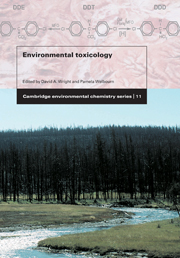Book contents
- Frontmatter
- Contents
- Foreword
- Preface
- Abbreviations
- Acknowledgements
- 1 The emergence of environmental toxicology as science
- 2 The science of environmental toxicology: Concepts and definitions
- 3 Routes and kinetics of toxicant uptake
- 4 Methodological approaches
- 5 Factors affecting toxicity
- 6 Metals and other inorganic chemicals
- 7 Organic compounds
- 8 Ionising radiation
- 9 Complex issues
- 10 Risk assessment
- 11 Recovery, rehabilitation, and reclamation
- 12 Regulatory toxicology
- 13 An overall perspective, or where to from here?
- Glossary
- Index
11 - Recovery, rehabilitation, and reclamation
Published online by Cambridge University Press: 05 June 2012
- Frontmatter
- Contents
- Foreword
- Preface
- Abbreviations
- Acknowledgements
- 1 The emergence of environmental toxicology as science
- 2 The science of environmental toxicology: Concepts and definitions
- 3 Routes and kinetics of toxicant uptake
- 4 Methodological approaches
- 5 Factors affecting toxicity
- 6 Metals and other inorganic chemicals
- 7 Organic compounds
- 8 Ionising radiation
- 9 Complex issues
- 10 Risk assessment
- 11 Recovery, rehabilitation, and reclamation
- 12 Regulatory toxicology
- 13 An overall perspective, or where to from here?
- Glossary
- Index
Summary
The context for site contamination and recovery
The present chapter deals with attempts to improve the condition of some historically contaminated sites, dealing mainly with technical or scientific aspects, but issues of policy also arise. In Chapters 6–8 we described the contamination of air, soil, and water by potentially toxic substances. We also pointed out in several places that, until relatively recently, there was a tacit acceptance of some degree of change in or damage to the environment resulting from industrial, agricultural, and other human activities. In the complex issues of Chapter 9, reference was made to the fact that environmental contamination usually involves a combination of several substances. While recent practice aims to minimise the contamination of the environment or, at the very least, provides for a plan to include the restoration of a site at the close of a project, the legacy of past activities in both developed and less-developed countries is manifest in the form of orphan sites that may be described as historically contaminated.
For the purposes of restoration or clean-up of contaminated sites, it is obviously necessary to have some means of defining what is meant by a contaminated site. As a starting point, we could consider as contaminated any site that has received substances that were either not previously present in that site or, as a result of some activity, are at significantly higher concentrations than were normal for the site.
- Type
- Chapter
- Information
- Environmental Toxicology , pp. 520 - 549Publisher: Cambridge University PressPrint publication year: 2002



